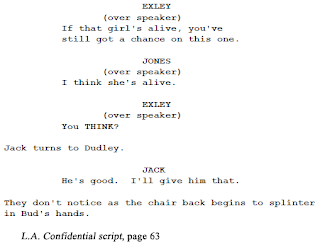SPOILER ALERT: This series of posts is spoiler-heavy. But, seriously, the movie is from 1997!!! If you haven’t watched it by now…
This post is a collection of examples of how Helgeland puts into practice the old adage, “Show, don’t tell.” I’ll add more examples to this post over time.
Ice, Ice, Baby
Starting on page 45, we are introduced to the palatial mansion of one Pierce Morehouse Patchett. Up ’til this point in time, Patchett has been a background player. We know he is significant, but don’t have the details.
One of the protagonists, Bud White, follows up a lead, arriving at Patchett’s place. Bud, a thuggish cop, does his best to intimidate Patchett.
Prior to the exchange, Patchett had been practicing his golf chipping, landing his shots in a tight group near a koi pond. The conversation, which goes for a couple of pages, has some real dialogue gems.
But what was really note-worthy was how Helgeland finishes the scene.
Bud turns, heads down the walk. Patchett hits his golf ball. It lands just past the koi pond, with the rest. Ice.
L.A. Confidential script, page 48
It’s a neat book-end to the opening of the scene.
But more than that, it is a fantastic summation of Patchett’s presence and calmness during the exchange. And rather than try and TELL us that Patchett is in control, Helgeland SHOWS us.
Brilliant.
Take a Seat
Another example of showing, rather than telling, is found on page 63.
Another of the protagonists, Edmund Exley, conducts an interrogation. During the course of his questions, he discovers that a girl has been kidnapped.
Bud, who has a real thing for helping women, and dispatching justice on those who abuse them, watches the interrogation from an observation room.
We pick it up as Exley questions a youth named Jones.
We don’t need to be told that Bud is angry. Seeing the effect of his anger is far, far better.
